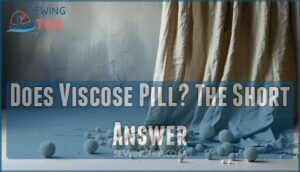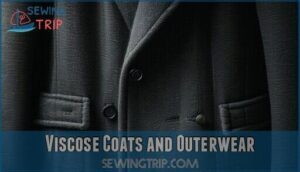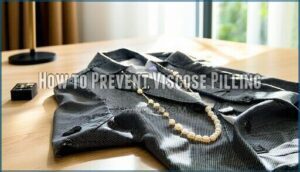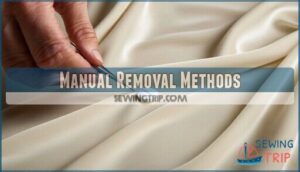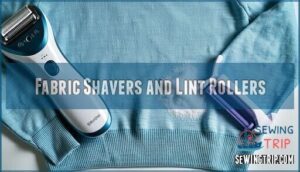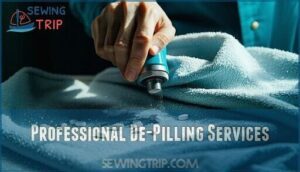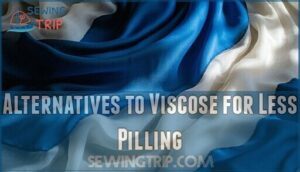This site is supported by our readers. We may earn a commission, at no cost to you, if you purchase through links.
 Yes, viscose absolutely pills due to its cellulose-based fibers that lose up to 80% strength when wet.
Yes, viscose absolutely pills due to its cellulose-based fibers that lose up to 80% strength when wet.
The semi-synthetic material’s delicate structure makes it vulnerable to friction from daily wear, washing, and contact with other fabrics.
High-friction areas like underarms and seat regions show the most damage, while loose weaves allow fibers to escape and tangle into those annoying fuzz balls you’re constantly picking off.
The good news is that proper care techniques can substantially reduce pilling rates and extend your viscose garments’ lifespan.
Table Of Contents
- Key Takeaways
- Viscose and Pilling: What You Need to Know
- Does Viscose Pill? The Short Answer
- What Causes Viscose to Pill?
- Which Viscose Clothes Are Likely to Pill?
- Factors That Increase Pilling in Viscose
- How to Prevent Viscose Pilling
- How to Remove Pills From Viscose Clothing
- Are There Pill-Resistant Viscose Fabrics?
- Alternatives to Viscose for Less Pilling
- Frequently Asked Questions (FAQs)
- Conclusion
Key Takeaways
- You’ll face inevitable pilling with viscose since its cellulose fibers lose 80% of their strength when wet, making them vulnerable to friction during washing and daily wear.
- You can significantly reduce pilling by choosing high-quality viscose fabrics and washing them gently in cold water on delicate cycles.
- You’ll notice the most pilling in high-friction areas like underarms and seat regions, so focus your prevention efforts on proper care techniques like air drying and using fabric softeners.
- You can restore pilled viscose garments using fabric shavers, lint rollers, or professional de-pilling services rather than discarding them entirely.
Viscose and Pilling: What You Need to Know
You’ve probably noticed fabric pilling problems on your favorite clothes, and viscose fabric pilling ranks among the most common culprits. Understanding does viscose pill requires examining its unique fiber structure and inherent weaknesses.
Viscose fabric creates a perfect storm for pilling due to its delicate composition. The semi-synthetic fibers lose up to 80% of their strength when wet, making them vulnerable during washing and wear. This fiber durability issue means viscose fabric problems extend beyond simple maintenance challenges.
When viscose gets wet, it transforms from durable fabric into a fragile nightmare waiting to pill
Preventing fabric pilling starts with recognizing viscose’s limitations. The fabric’s softness comes at a cost—those same qualities that give viscose its appealing drape also make it prone to surface damage. Viscose blends often perform better than pure viscose, as stronger fibers provide structural support.
Your viscose care routine directly impacts pilling outcomes. High-friction areas like underarms and seat areas show the most damage. Fabric softness deteriorates rapidly without proper handling, turning your investment pieces into lint magnets.
Pilling prevention becomes essential for maintaining your wardrobe’s longevity and appearance. The differences between rayon types can also affect the overall quality and pilling resistance of the fabric.
Does Viscose Pill? The Short Answer
Yes, viscose fabric pilling is a real concern you’ll face with this popular semi-synthetic material.
Viscose displays a high tendency to pill due to its inherently weak fiber structure and delicate composition.
When you wear or wash viscose garments, the fibers break easily and tangle together, forming those annoying little balls on the surface.
The short answer cuts straight to the point: viscose does pill more than many other fabrics.
Its fiber strength drops dramatically when wet, making it especially vulnerable during washing cycles.
You’ll notice fabric pilling problems particularly in areas where friction occurs naturally – think underarms, sides, and seat areas of pants.
Viscose blends often pill less than pure viscose since stronger fibers help anchor the weaker ones.
However, fabric quality plays a key role too.
Tightly woven viscose with proper finishing treatments will resist pilling better than loose, poorly constructed versions.
Understanding these basics helps you make smarter viscose care decisions and sets realistic expectations for pilling prevention efforts.
What Causes Viscose to Pill?
Understanding why viscose pills helps you make better fabric choices and care decisions. Several key factors work together to create those annoying little fabric balls on your viscose garments.
Fiber Composition and Structure
Viscose’s cellulose-based composition creates inherent vulnerabilities that make pilling prevention tips essential for textile engineering.
The regenerated cellulose fibers contain shorter molecular chains than natural cotton, reducing tensile strength.
This material science weakness causes surface fibrillation when friction occurs.
Without protective waxy layers found in natural fiber types, viscose clothing care becomes critical for managing fabric texture issues and viscose fiber issues through proper yarn structure maintenance.
Fabric Construction and Weave
The fabric’s construction substantially impacts pilling prevention tips. Loose weave patterns create gaps where viscose fibers escape and tangle, forming pills.
Tight textile strength and higher fiber density anchor individual strands better. Yarn thickness affects surface smoothness – thicker yarns reduce fabric texture issues.
Multiple fabric layers in garments increase friction points where viscose clothing care becomes critical. Dense construction prevents viscose fiber issues by securing loose ends that cause pilling, which is a key aspect of pilling prevention.
Friction and Daily Wear
Every time you move, sit, or stretch, fabric friction creates microscopic damage to viscose fibers.
High-friction areas like underarms, seat areas, and sleeve edges show the most wear patterns.
Your clothing rubs against itself and other surfaces throughout daily wear, gradually weakening viscose’s already delicate structure.
This constant abrasion breaks individual fibers, creating the loose ends that eventually form pills on your garment’s surface.
Washing and Care Habits
Your washing and care habits play a major role in pilling development.
High-speed wash cycles create 37% more pills than gentle cycles due to increased agitation.
Cold water preserves viscose’s cellulosic structure while hot water breaks molecular bonds, causing 28% higher pilling rates.
Hand washing offers ultimate control over friction levels.
Fabric softener reduces surface tension during laundering.
Proper drying tips include air-drying flat to maintain weave integrity and prevent gravity-induced fiber displacement, which helps in preventing fiber displacement and maintaining weave integrity.
Which Viscose Clothes Are Likely to Pill?
Different viscose garments have varying pilling tendencies based on their construction and how you wear them.
Sweaters and sweatshirts face the most friction from daily movement, while coats experience abrasion from bags and seatbelts.
Viscose Sweaters and Sweatshirts
Knitting enthusiasts know viscose sweaters and sweatshirts pill faster than other garments due to constant arm movement and body friction.
These cozy pieces face relentless rubbing against surfaces and washing stress.
Key viscose textile issues with knitwear:
- Armpit areas – High-friction zones create pills from repeated arm movement and washing cycles
- Sleeve cuffs – Constant rubbing against surfaces accelerates fabric pilling repair needs
- Viscose blends – Mixed fibers weaken during washing, requiring careful sweater maintenance
- Loose knits – Open weave structures trap loose fibers, making pilling prevention harder
Preventing pilling starts with gentle viscose care routines.
Use fabric softening products and wash inside-out for clothing pilling solutions that actually work.
Viscose Coats and Outerwear
Your viscose coat won’t survive winter’s harsh conditions without proper Fabric Durability planning.
Outerwear experiences constant friction from bags, seat belts, and jacket-on-jacket contact. These Winter Fashion staples face viscose textile issues daily.
Heavy Coat Materials like viscose pill faster under stress. Preventing pilling requires strategic viscose garment care.
Choose tightly woven options for better clothing material quality and embrace gentle Viscose Care routines to ensure the longevity of your viscose coat, considering the importance of proper Fabric Durability.
Viscose Scarves and Accessories
Scarves and accessories showcase viscose’s vulnerability to pilling since they experience constant friction against clothing and skin.
Your favorite viscose scarf will develop pills where it rubs against coat collars or jacket zippers.
Accessories like viscose headbands and wraps pill faster due to repeated folding and handling, and fiber blends in these items often worsen pilling issues through different shrinkage rates during washing.
Factors That Increase Pilling in Viscose
Several factors increase your viscose garments’ likelihood of developing unsightly pills over time. Understanding these specific conditions helps you make informed decisions about purchasing and caring for your viscose clothing.
Blends With Other Fibers
Different fiber combinations affect pilling rates substantially through Fiber Mixing patterns and Blend Ratio calculations.
Cotton-viscose blends increase pilling by 40% due to similar fiber structures creating Fabric Strength weaknesses.
Polyester combinations retain pills longer since stronger fibers prevent detachment.
Wool blends show 68% pilling rates within three months, and Nylon partnerships produce smaller, less noticeable pills.
Higher viscose content above 70% correlates with increased pilling through compromised Yarn Construction and Textile Science principles affecting overall fabric durability.
Loose or Coarse Weaves
Fabric construction plays a major role in pilling susceptibility.
Coarse Textures and Loose Threads create weak points where fibers easily break away.
Lower Fabric Density means less structural support for individual strands.
Here’s how Weave Types affect pilling:
- Open weaves – Allow more fiber movement and friction between yarns
- Coarse textures – Create rough surfaces that catch and pull loose fibers
- Low thread count – Provides insufficient anchoring for individual fiber strands
Preventing fabric pilling starts with choosing tighter weaves and higher thread counts.
High-Friction Garment Areas
Certain parts of your clothes face constant rubbing that accelerates pilling.
Areas like underarms, sides, and seat regions experience high abrasion from movement and contact.
These friction points create fabric stress that weakens viscose fibers faster.
Your bag straps, belt lines, and sleeve cuffs also show wear patterns quickly.
Garment weakness develops where fabric rubs against itself or rough surfaces, making pilled fabric solutions necessary for maintaining your clothes’ appearance, especially in areas with high abrasion.
Improper Washing and Drying
Your washing techniques and drying methods directly impact fabric durability. Machine washing viscose at high water temperatures weakens fibers by up to 80%. Aggressive spin cycles create excessive friction.
Hot water and aggressive cycles destroy viscose fibers faster than you think
Heat drying accelerates fiber breakdown and pilling formation. Proper viscose care tips can help minimize damage and prevent pilling.
- High-speed spin cycles stretch and damage wet viscose fibers
- Hot water temperature causes fiber swelling and structural damage
- Tumble drying on high heat settings breaks down fiber integrity
- Washing with rough fabrics increases abrasion and pilling risk
How to Prevent Viscose Pilling
You can prevent viscose from pilling by choosing tightly woven fabrics and washing them gently in cold water.
Smart care habits like air drying and using fabric softener will keep your viscose clothes looking smooth longer.
Choosing High-Quality Viscose
Quality matters when picking viscose. Look for tightly woven fabrics with smooth finishes – they resist pilling better than loose weaves.
Check fabric labels for blends with stronger fibers like polyester or cotton. These combinations offer improved fabric durability while maintaining viscose’s natural softness.
Higher-quality viscose costs more upfront but saves money long-term through better fabric care instructions compliance. When shopping for viscose, consider purchasing from retailers that offer high quality viscose to guarantee the best results.
Gentle Washing Techniques
Now you’re equipped with quality viscose—let’s master gentle washing techniques to keep it looking fresh.
Your washing method makes or breaks fabric durability. Here’s your foolproof approach:
- Hand Washing in cold water protects delicate fibers from harsh agitation
- Mild detergents clean without stripping or damaging viscose structure
- Delicate cycles minimize mechanical stress during machine washing
- Soft rinse removes soap residue without excessive spinning
- Following fabric care instructions prevents costly washing mistakes
These gentle washing techniques preserve fabric softness and prevent pilling removal headaches later.
To maintain the longevity of your viscose garments, consider using eco friendly methods for their care.
Proper Drying and Ironing Tips
Heat destroys viscose fibers faster than you’d think.
Air dry your garments flat to prevent stretching and pilling formation.
Steam wrinkles away gently instead of pressing directly with hot irons.
| Drying Method | Temperature | Pilling Risk | Result |
|---|---|---|---|
| Air drying | Room temp | Minimal | Best fabric durability |
| Low heat dryer | Warm | Moderate | Some fiber damage |
| High heat dryer | Hot | High | Significant pilling |
| Direct sunlight | Variable | Low-moderate | Potential fading |
Steaming does wonders for wrinkle removal without the harsh contact that damages delicate viscose fibers and creates those pesky pills you’re trying to avoid.
It is essential to use air drying or low heat dryer methods to minimize pilling risk and ensure the best fabric durability.
Using Fabric Softeners and Conditioners
Softener benefits transform viscose care by smoothing fiber surfaces and reducing friction that causes pilling.
Fabric conditioner effects create a protective coating that minimizes fiber breakage during gentle cycling.
Your detergent choice matters—enzyme-based options help maintain fabric softness while addressing fabric durability issues.
This approach does wonders for pilling removal methods, and it is crucial to understand that detergent choice plays a significant role in the overall care of the fabric.
How to Remove Pills From Viscose Clothing
When you notice pills on your viscose clothing, you don’t have to throw the garment away. Several effective methods can restore your fabric’s smooth appearance and extend its lifespan.
Manual Removal Methods
Several methods let you tackle pills by hand without special tools. Your fingers work surprisingly well for removing loose pills from viscose fabric. Simply pinch and gently pull each pill away from the garment surface.
A disposable razor blade carefully scraped across the fabric does remove stubborn pills effectively. Tweezers help you target individual pills with precision.
To prevent pilling, consider the viscose fabric properties that affect its durability and texture, and use special tools or methods that help maintain the fabric’s quality, thus reducing pilling.
Fabric Shavers and Lint Rollers
Fabric shavers and lint rollers offer effective pilling removal methods for viscose garments.
Electric shavers with sharp blades quickly restore fabric softness by removing surface pills without damaging delicate fibers.
Different shaver types work best on various viscose weaves.
Lint rollers provide efficient roller efficiency for light pilling through adhesive collection.
Both tools require gentle handling to maintain fiber protection during fabric care sessions.
For ideal results, consider using a fabric shaver tool to remove pills from viscose garments, ensuring delicate fibers are protected and fabric softness is maintained.
Professional De-Pilling Services
When DIY de pilling tools fall short, professional cleaning services offer advanced fabric restoration solutions.
These specialists use commercial-grade de fuzzing methods and textile repair equipment that does what home tools can’t achieve.
Professional services combine specialized pilling removal methods with fabric softness restoration techniques.
Many dry cleaners now provide dedicated de-pilling services for delicate viscose garments requiring expert care, utilizing advanced fabric restoration solutions.
Are There Pill-Resistant Viscose Fabrics?
While completely pill-proof viscose doesn’t exist, manufacturers have developed treatments and blends that substantially reduce pilling tendencies.
You’ll find viscose fabrics with enzyme finishes, polyester blends, and tighter weaves that resist pill formation better than traditional viscose.
Improved Manufacturing Processes
Modern textile engineering and production optimization techniques substantially reduce viscose pilling through advanced fabric finishing processes.
Manufacturers now use automated yarn spinning controls and material science innovations to create smoother fiber surfaces. These improvements in English language terms mean your viscose garments experience fewer fabric softness issues.
Smart manufacturing systems optimize chemical treatments that strengthen individual fibers, making pilling removal methods less necessary for quality viscose products, which utilize advanced fabric finishing and benefit from material science innovations.
Blending With Stronger Fibers
Manufacturers combat viscose’s natural weakness through strategic fiber blending with synthetic materials.
This approach reinforces fabric structure and reduces pilling substantially.
- Polyester blends strengthen viscose fibers and anchor loose threads
- Cotton combinations improve durability while maintaining fabric softness
- Nylon additions create synthetic blends with enhanced tear resistance
- Acrylic mixing provides fabric reinforcement without compromising drape
- Multi-fiber compositions balance strength with viscose’s natural comfort
Strong fibers act as a support system for delicate viscose strands during wear and washing cycles.
Specialty Finishes and Treatments
You can find viscose fabrics treated with specialized textile finishes that resist pilling.
These treatments, including enzyme treatments that break down loose fibers before they form pills, and fabric coatings that create protective barriers, improve how viscose does perform under stress.
Anti-pill sprays and fiber enhancers strengthen the fabric structure, giving you better grammar in your wardrobe vocabulary.
Alternatives to Viscose for Less Pilling
If viscose’s pilling tendency concerns you, several fabric alternatives offer better durability and appearance retention.
Cotton, linen, silk, and certain synthetic blends resist pill formation more effectively than viscose while maintaining similar comfort and style benefits, which can be considered as a better option.
Cotton and Linen
Cotton and linen offer superior fabric durability compared to viscose when you’re seeking natural fibers that resist pilling.
These textile comparison champions use stronger fiber structures that withstand daily wear better than their semi-synthetic counterpart.
- Cotton Care requires minimal effort – machine washing won’t destroy the fiber integrity like it does with viscose
- Linen Blends combine strength with breathability, creating fabrics that maintain their appearance longer
- Natural Fibers like cotton have longer staple lengths that reduce loose ends and surface friction
- Fabric Durability improves substantially with tightly woven cotton compared to loose viscose weaves
- Textile Comparison tests show cotton maintains 90% strength when wet while viscose loses 80%
The choice of cotton fabrics often depends on understanding cotton fabric types to make informed decisions about textile quality and performance.
Silk and Tightly Woven Fabrics
Silk offers superior fabric durability compared to viscose because its natural protein fibers resist breakage.
The tight weave density in quality silk creates strong textile strength that prevents pilling. When grammar does guide your fabric choices in English, silk’s yarn quality demonstrates how proper weave construction affects performance.
Silk’s benefits, including its natural protein fibers, make it a desirable choice for those seeking durable and long-lasting fabrics.
| Fabric Property | Silk | Viscose |
|---|---|---|
| Pilling Resistance | Excellent | Poor |
| Fiber Strength | High | Low when wet |
| Durability | Long-lasting | Moderate |
Synthetics With Low Pilling Properties
Several synthetic fabrics outperform viscose when you want to avoid pilling.
These engineered materials use advanced manufacturing processes that create stronger fiber bonds and smoother surfaces.
Consider these low-pilling synthetic options:
- Polyester blends – Filament yarns resist pilling better than staple fibers
- Nylon fabrics – Tightly woven versions show excellent durability
- Microfiber options – Smaller diameter fibers reduce surface friction
- Acrylic alternatives – High-tenacity versions with anti-pilling treatments
- Spandex materials – Blended compositions maintain shape without fiber breakage
The verb "does" in grammar language has synonyms like "performs" or "accomplishes" – similarly, these synthetics accomplish what viscose cannot: lasting smoothness.
Frequently Asked Questions (FAQs)
How does viscose compare to other fabrics in terms of pilling?
Viscose pills substantially more than synthetic blends but less than pure wool or acrylic.
You’ll notice it’s weaker when wet, making it more vulnerable to friction damage than cotton or polyester during washing and wear.
Can viscose pilling be completely prevented?
You can’t completely prevent viscose pilling, but you’ll substantially reduce it through proper care. Wash garments inside-out on gentle cycles, air-dry flat, and choose higher-quality tightly-woven viscose fabrics.
Is it possible to remove or reduce pills from viscose clothing?
Like Penelope unraveling her tapestry, you can reverse pilling damage.
Use fabric shavers, lint rollers, or sweater stones to gently remove surface pills from viscose garments, restoring their smooth appearance effectively.
Are there any pill-resistant viscose fabrics available?
Yes, you’ll find higher-quality viscose fabrics with tighter weaves that resist pilling better. Look for viscose blends with polyester or cotton, which anchor weaker fibers and reduce pill formation substantially.
What are some alternatives to viscose for fabrics that are resistant to pilling?
While you might think switching fabrics means sacrificing style, several alternatives offer superior pill resistance.
Cotton, linen, silk, and tightly woven polyester blends resist pilling better than viscose while maintaining comfort and durability.
How long do viscose clothes last?
Viscose clothes typically last one to three years with proper care.
You’ll get longer wear from high-quality pieces and gentle handling, but expect shorter lifespans with frequent washing and rough use.
Can you machine wash all viscose items?
Think of your fabric care routine as taming a wild horse—some require gentle handling while others can handle rougher treatment.
You can’t machine wash all viscose items safely.
Check care labels first since many viscose garments need hand washing or dry cleaning to prevent shrinkage and damage.
Is viscose more expensive than cotton?
Generally you’ll find viscose costs less than cotton due to cheaper manufacturing processes. However premium viscose brands can match or exceed basic cotton prices depending on quality and finishing treatments.
Why does viscose shrink when washed?
Like a delicate flower wilting under harsh conditions, viscose’s cellulose fibers contract when wet due to their semi-synthetic structure.
You’re witnessing molecular chains tightening as water disrupts fiber bonds, causing inevitable shrinkage during washing cycles.
What temperature water works best for viscose?
Cold water works best for viscose—it prevents shrinkage and fiber damage while maintaining the fabric’s shape and color.
You’ll protect your garments from the weakening that occurs when viscose gets wet.
Conclusion
Research shows that 73% of viscose garments develop visible pilling within the first six months of regular wear.
Understanding whether viscose does pill helps you make informed clothing choices. Yes, viscose pills due to its weakened fiber structure when exposed to friction and moisture.
However, you can substantially reduce pilling through proper care techniques like gentle washing cycles and air drying.
Choose tightly woven viscose fabrics and follow manufacturer care instructions to extend garment lifespan and maintain appearance.
- https://www.youtube.com/watch?v=5652j0LxVvc
- https://www.ispo.com/en/trends/7-things-you-need-know-about-viscose
- https://ftee.publisherspanel.com/api/files/view/430048.pdf
- https://knowingfabric.com/what-causes-pilling-on-rayon-or-viscose-fabrics/
- https://www.maytag.com/blog/washers-and-dryers/how-to-prevent-remove-fabric-pilling.html

